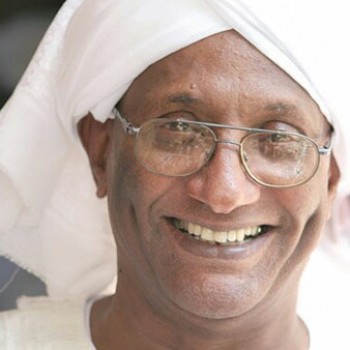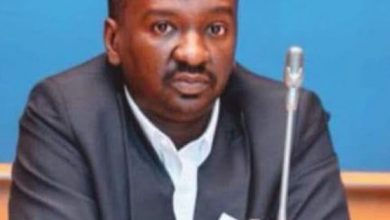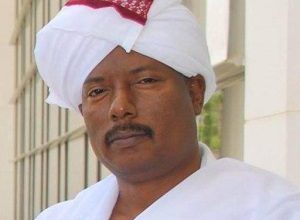About Abdullah Jalab’s Intellectual Fragrances

My brother Dr. Abdullah Ahmed Jalab has departed for the world. I had reviewed his book “The First Islamic Republic” (Ashqeet 2007), the first of his trilogy about the Salvation State. The presentation was translated by our mutual friend, the late Muhammad Abdullah Ajimi, may Allah forgive him. I am publishing it here to reflect Jalab’s intellectual fragrance in us and because his ideas are much needed in our discourse following the fall of the Salvation (and the previous one), which always seemed to me as if he did not read the Salvation as Jalab wanted.
Islamic Salvation: Bond, Comprehensive , and Capitalism
Abdullah Ali Ibrahim
I remember reading in the sixties of the last century by a wise man who said that we keep carrying out failed revolutions because of the poor books we read about revolution and disobedience.
On the approaching twentieth anniversary of what Abdullah Jalab calls the “Islamic Republic” (1989-) (in its various phases) in Sudan, which its hasty enemies predicted would melt away under the weight of its first autumn in power, one is tempted to attribute its cohesion and survival to the many bad books that have been written about it. These books have been, in large part, premature eulogies of a movement and a state that refuse to die. Jalab has written a different book about the stubbornness and determination of that Islamist state. He tries to explain the dynamics of the state more than he tries to judge it.
Yet I was impressed by the tools he uses to tell the story more than by the highly authoritative research that has resulted. Unlike other scholars of the state, who treat it as an anomaly worthy of condemnation rather than theoretical reflection, Jalab tells its story as if Western theory were indispensable to understanding and dealing with this almost pariah institution.
He casts his net far and wide in search of a harbor for it (and we have presented in the English text the many Western concepts that Jalab used to understand Turabi’s Islamic state. We will not burden the reader of the newspaper with them, and the reader who seeks more will find them in the English text of this presentation). I wish that Jalab had contemplated these concepts more deeply to better illuminate the dynamics of the Islamic state. Jalab also tells the story of the Islamic state in Sudan as if communism in Sudan (the reality that has received, without a doubt, the least amount of study in the second half of the last century) is something that must be addressed in order to understand Turabi’s Islamic state.
The Islamic movement emerged in the midst of a fierce competition to win the hearts and minds of the Sudanese with an active and vibrant communist party with deep-rooted foundations. This movement could have ignored the Marxist party on the grounds that it was foreign in origin and not dangerous. If this ignorance had tempted it, it would have embarked on an adventurous boat of neglecting this competing party and swallowed the bitterness of failure. Jalab’s masterful presentation of the October 1964 revolution reveals their rivalry, the Islamic movement and the Communist Party, for the people’s conscience at one of the peaks of the political-cultural conflict in Sudan.
The important thing is that the Islamic movement’s quest to spread its ideology to achieve the Islamization of the state began in the center and in a long and difficult confrontation with the Communist Party and the so-called “modern” forces in the northern cities and urban areas in the fifties, sixties and part of the seventies of the last century.
Later, this process of Islamization of the state was marginalized (it moved from the center to the peripheries).
In other words, it overflowed to the margins without prior planning. Turabi, as Jalab suggests, was closely monitoring the Communists and adopting their methods of work.
Moreover, Jalab dealt with the Islamic state as if the writings in Arabic about it in Sudan were an indispensable reference. The writers who carry ideas and viewpoints about the Islamist experience occupy an advanced position in Jalab’s book: Al-Tayeb Zein Al-Abidin, Haidar Taha, Abdul Wahab Al-Afandy, Al-Tijani Abdul Qadir, Amin Hassan Omar, Mohamed Saeed Al-Qaddal, Mahmoud Qalandar, Hassan Makki, Issam Mirghani, Haidar Ibrahim, and Muhi Al-Din Abdul Rahim.
The strength of Jalab’s story about the first Islamic state is due, in large part, to his diverse readings in our local Sudanese political literature. Jalab, for those who do not know him, is a poet.
His poeticism here was a suitable tool for eloquently summarizing the story of the Islamic state. I was very impressed by the way he portrayed the activity of the Islamic movement during the era of President Nimeiri (1978-1985). He said that it was represented in three migrations: the first migration to the “camp,” that is, the period of residence of the Islamists with other opposition forces in Libya to confront the regime militarily, and this was represented in the failed attempt to invade Sudan in 1976. The second migration was to the “campus,” where that campus became the engine of the Islamic movement.
The third migration was to what Jalab calls the “land of plenty.” I wish, in order to maintain the rhythm, that he had called it the “land of companies and corporations,” a term he eventually resorted to using to refer to the movement’s immersion in capitalism through the Islamic banking system that it created.
If there is one thing this well-crafted story urges us to do, it is to reconsider our image of Turabi as a mafia-like leader. The light that Jalab sheds on how his state works does not support this image that his opponents constantly brandish.
Turabi wanted to rule without competition, but he clashed with the conventions of the skilled professions in the bureaucracy, the army, and the media, which did not surrender to him and clung to their wounded professionalism. Turabi, in Jalab’s description, is a man who sought to monopolize power and rule it alone. But Allah is the only omen.
Even the bureaucratic apparatus that the regime had shaken to the core did not surrender easily. The successive purges it was subjected to demonstrated that the strength of institutions “lies in their integrity, impartiality, professionalism, and collective solidarity” (p. 111). Even the carefully selected Islamist bureaucrats succumbed to the “rationalization and rationalization of the state bureaucracy,” distancing themselves from the hostile actions and misconceptions of the ruling party (143). Turabi was defeated by those Islamists who were tamed by the bureaucracy’s utilitarian orientation.
The flexibility of this bureaucracy was nurtured on the milk of the institution’s living trade union traditions. The political tradition of opposition to the military regimes (1964 and 1985), which Jalab calls “the Sudanese civil religion (134),” had cast its deadly spell on the Islamist regime, despite its stubbornness in clinging to power.
However, most of the regime’s longevity and its brutality were a gift from its wicked and impatient opponents. The army, in turn, was reluctant and fed up with Turabi’s dictates. He escaped his project, which he aimed to solve under the pretext of bridging the gap between civilians and the military (p. 117).
In a fit of anger, Turabi rebuked the army for its failure to cross the border into Eritrea and gave them a hot and unforgettable beating. The clerics, on the other hand, did not like him because he prevented them from forming a jurisprudence council that would enable them to control discussions and delve into matters related to religion. It is not surprising that Dr. Ahmed Ali Al-Imam, the president’s advisor for authentication affairs, emerged as one of the signatories of the Memorandum of Ten (December 1999) that signaled Turabi’s downfall. Turabi did not even trust Bashir, whom he claimed to have personally selected for the presidency.
Jalab describes their relationship as a “power struggle” (p. 130) that had been brewing over the years. Suffice it to say that Bashir had thwarted Turabi’s desire to become his deputy following the plane crash in which former deputy Al-Zubair Mohamed Salih was killed.
The Sudanese were overwhelmed with sadness when Turabi’s desires were revealed, as they could not believe that a man of his stature and status could bow his head to this degree in the corridors of power. Turabi is not the undisputed “monster of the political screen” as his opponents portray him. He was forced to live under his chains.
On the other hand, the press, the field of Jalab’s long experience and the field of his academic degree, was frank in expressing its disbelief in the wisdom aimed at shaping minds (144) and reformulating them at the request of Turabi’s regime. Hence, Sudanese writers and readers were adept at creating their “media alternative” (p. 144). Wedding occasions and evening parties became crowded with political discussions, thus breaking the barrier of the culture of fear.
In addition, globalization came to provide people with alternatives, so they turned to other television channels and radio stations, not only in search of news, but also for entertainment. This reluctance to engage with the state media stems from a long tradition of getting news from “Here in London,” the BBC, as a reliable source.
The written press, which Jalab says did not surrender to the regime, survived the onslaught of the Turabi regime either by being published from outside the country or by opening its pages to experienced journalists who excelled in using the margin of freedom available, however narrow and uncertain, to serve the cause of freedom. Pressures for an independent written press succeeded, and the regime allowed it in the late 1990s. The hornet’s nest opened as soon as these writers concerned with public affairs reopened the national dialogue about the country’s future, which had been interrupted by the 1989 coup.
Jalab concludes, and he is right, that Turabi’s first Islamist state not only failed to shape people’s minds and concepts, but that it also disintegrated and died a slow death thanks to these journalists who were not afraid to tell the truth to power in the pages of their newspapers, which had regained their freedom and independence.
The idea of opposition and dissent within the ranks of the Islamist movement itself has been nurtured by these restored outlets. Jalab pays tribute to the role of the written press, which deserves “more praise than most people know” (p. 147). Jalab rightly describes the post-Turabi state as “more like the military state of Nimeiri” (p. 131). There is nothing new in this. This was also the character of Turabi’s state. But Turabi and his critics alone did not see this, since they focused on the state’s religion, not its dictatorship.
By removing Turabi from power, the state only shed an ideology that had lost its political market: Islam. The military under Nimeiri did the same with socialism, just as Milly Robert said of Algeria: “If nations have armies, the Sudanese army has a nation.” Half a century of practicing politics by other means has entrenched the military in power, so that officers have become statesmen rather than fighters.
They were statesmen (not ideologues) in a “shopping spree” searching for ideologies that soldiers would die for as long as the purely nationalistic impulse no longer inspired or stirred the hidden. The ideology they found, whether it was Nimeiri’s socialism or Bashir’s Islamism, was the “intoxication of power.” If pressure intensified on these soldiers to choose power or its intoxication, they would choose power and abandon the intoxication, i.e. ideology. This is the basis for the current regime’s avoidance of much delving into the Islamism of the State.



